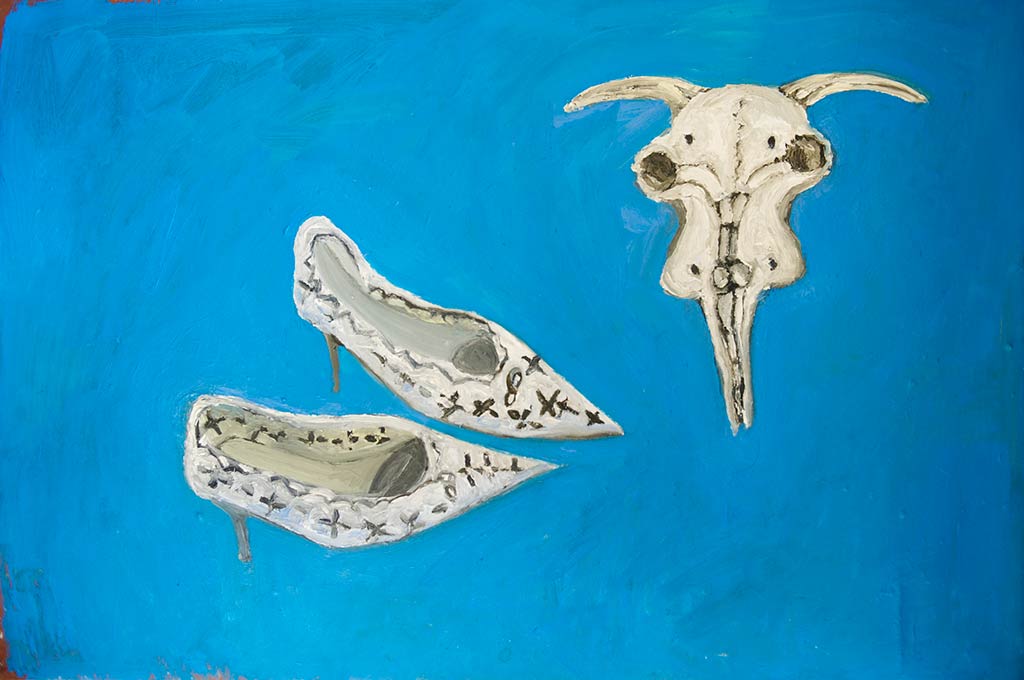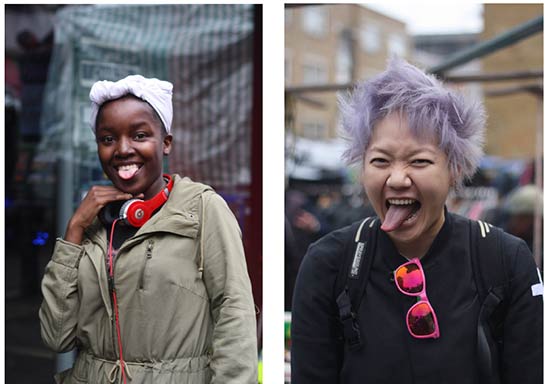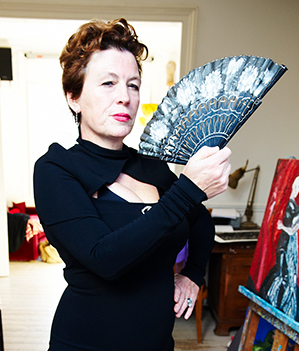Facets of Beauty
London-based Tatiana de Stempel tells us how the politics of beauty and the politics of art are intrinsically bound together, inviting artists and viewers alike to constantly rediscover and redefine the beauty in art and the art of beauty
Praveena Shivram
Reading Toni Morrison is like diving head first into the wild waters of the mountains. It consumes you in one swift motion, closing over you in one breathless rush, and if you allow your body to relax and let the current find its rhythm on your skin inside this temporary womb of self-discovery, you will come out re-born. So, why am I talking about Toni Morrison in an interview with Tatiana de Stempel? Probably because as artists – one of the written word and the other of the visual word – they are not very different. At least, the politics of identity that they work with is like the different shades of the same fruit. And the impact they create is like the tree, strong and upright, that bears that fruit.

‘Women carry the burden of beauty in our culture and who are visually objectified in the “male gaze”, which Luce Irigaray examines in her work This Sex Which Is Not One. Often it is white female characters, which are entrapped in the “male gaze’’ as a standard of female beauty. Toni Morrison reconsiders female beauty in her book, The Bluest Eye and Baby Tar, where she rejects beauty as defined by white female consumer culture as both frivolous and racist. In What the Black Woman Thinks About Lib (1971) Morrison discusses images of black female beauty that black women have taken on in response to the dominance of white female beauty. In this work she wonders if it is better for black women to remain useful as beauty is “romanticism”. In this regard, once women get older and lose their youthful/beautiful looks, they appear to become invisible in society,’ Tatiana says over an e-mail interview. It hardly felt like a coincidence that she chose to quote from Morrison’s work, or a coincidence that she felt ‘I knew her’, purely from my voiceless questions and reading of her work. It’s no coincidence, because feminism is simply not built on a series of serendipitous happenings but on stubborn reality. Much like beauty itself.
In 2016, Tatiana’s hugely successful and widely toured solo show What Colour Would You Choose (WCWC), a series of photographs, drawings and film clips, took on the interesting aspect of skin colour based on the simple yet powerful premise that no matter what colour your skin is, the colour of your tongue is the same. As you look at her cheeky, feisty, playful and deeply profound images of people from different walks of life showing you their tongue, instantly, in the image and in your own face, the eyes crinkle up with a smile, the body relaxes in that undercurrent of camaraderie pushing across the boundaries of geography and the four sides of the image, and you feel transported into the unknown realm of new experiences, and you are, well, re-born.
In one of Morrison’s iconic books, Sula, one of the protagonists, Helene, is in the train, struggling to find empathy in those of the same skin colour as hers. ‘Her glance moved beyond the white man’s face to the passengers seated behind him. Four or five black faces were watching, two belonging to soldiers still in their shit-colored uniforms and peaked caps. She saw their closed faces, their locked eyes, and turned for compassion to the gray eyes of the conductor.’ Or, in the case of Tatiana’s What Colour Would You Choose, we turn to the pink tongues of nameless strangers.

Excerpts from the interview
So much of our understanding of beauty and the politics that surround it have got to do with one’s skin colour. I am curious to know how you bridged your own conditioning process – what we grew up with, what we have seen and heard and learnt – with the liberating landscape of art. What surprised you about yourself as an artist while working on ‘What Colour Would You Choose’?
Well, it was not easy to bring this project to fruition because I do not have dark skin, racism has not affected me personally and I have grown up with privileges living in West London. But this does not stop me from seeing that there is racism and injustice in the world. I grew up in Notting Hill Gate when the first wave of Caribbean people came to London to work for London Transport. I would hear Reggae music and I could see that there was a whole different culture and way of looking and being.
During this time, I saw a theatre show called the Black and White Minstrel, where white people blackened up and did various dance routines. I was shocked by these shows and how they mimicked and caricatured black people and this was the seed of what would become the WCWC project. Many years later, over a series of discussions with a friend about racial discrimination and skin colour, especially with regard to the fairness creams seen on large advertising boards in every major capital city in India, WCWC came to be. Shadeism has been internalised in the United States, India, Pakistan and the Caribbean countries where there is a thriving market for fairness creams because even within the darker skinned community there is a prejudice from the past. Popular culture and literature has exploited this myth of female beauty and sexual attractiveness with lighter skin being thought of as more desirable and attractive than darker skinned women. Black and Asian men also internalise Eurocentric standards of beauty and associate femininity and sexual desirability with lighter skin, and dark skin with masculinity and male sexuality. In fact, the origins of colourism are widely believed to have come from the pigmentocracy of slavery, according to Ruth Fisher, project manager of the Understanding Slavery Initiative.
In WCWC, I wanted to explore as an artist the issues related to the colour of people’s skin and the social discrimination that it perpetuates. I felt that art could be a way to explore these issues; and, however justified I felt about my intentions, it was from Asian women writers that I received the most criticism regarding this project. So art here was not liberating but more about learning that there are huge issues to overcome before some black artists can feel comfortable working with some white artists and how white artists need to understand and have sensitivity to the issues of racism.

Do you necessarily believe that the purpose of art is to mimic beauty in all its misshapen, mangled, distorted glory or to remind the world that beauty can go beyond mere semantics towards something more visceral?
No, I don’t believe the purpose of art is to mimic beauty. I think the purpose of art is to question and examine our pre-constructed ideas of what beauty is. Ideas of beauty for woman have been trapped in the “male gaze” and we can see this throughout the Western history of art, in the numerous, mainly naked, white woman from Botticelli’s Birth of Venus to Manet’s Olympia. The Guerrilla Girls’ famous statement “Do women have to be naked to get into the Met. Museum?” confirms this as less than five percent of the artists in modern art sections are women, but 85 percent of the nudes are female. Male artists have tended towards exoticism and orientalism when depicting women from non-Western cultures as seen in Matisse’s odalisque paintings.
I do feel that the purpose of art now is to re-examine our preconceived ideas of what beauty is and how we conceive beauty away from a white male perspective, from the Eurocentric stereotypical ideal of female beauty to include what beauty is for black, Asian, gay and transgender communities, or older women. I do think that beauty in art has the possibility to be highly romanticised as seen in the pre-Raphaelite paintings.

In one of your drawings titled ‘Facebook 2’ you take on this perception of the ‘image’ head on. We are bombarded with ‘profile images’ and this constant need to look ‘pretty’ and visually show the world ‘that we are’. As an artist, do you feel this need to project an image of who you are through your work? And does that necessarily have to be a prettified version?
Well, who you are is naturally reflected in your art, although artists such as Duchamp depicted himself as a woman called Rrose Sélavy. I have wondered how it would be different to be a man, and in this Facebook 2 I was playing with the idea of being many different people, that is, a Jewish man or a gay Sikh. I was influenced by Cindy Sherman and Oreet Ashery. I also worked with photographer Jens Marott where I was putting on different costumes and taking on different personas. I was not thinking about being pretty but more about taking on multiple personalities. This is something I wanted to explore in this work and as a live street performance to see how people would treat you differently depending on who you appeared to be. I do think art offers the possibilities to escape who we are and be someone else.
Do you think that because we live in a virtual space that places such an inordinate amount of importance on the physical body – on how everything is beautiful no matter your body type or skin type or hair type – we attach undue importance to the word ‘beauty’ itself, on how we respond to it? And, therefore, or how we respond to art?
I do think it is hard on young people now when everything you do is photographed on social media. There is a lot of pressure to be beautiful whatever you are doing. We are saturated with visual images of ourselves. This not only creates a great deal of pressure to be beautiful but it also creates narcissism. Falling in love with our own image cannot create a caring or mature society. This was reflected recently when some tourists went to Auschwitz and took selfies there.

Taking off from the previous question, there was a time when beauty meant a certain thing – we had clear definitions and meanings to work with, as against this vast open-ended ocean of meaning we are grappling with. If you had a choice as an artist, which scenario would you prefer to create your art – experimenting within a rigid framework and pushing boundaries or working in an endless landscape creating specific boundaries within?
If I had a choice, I would always prefer to be creating my own boundaries than boundaries in a rigid framework. I always think that as an artist you have your own discipline and you are exploring possibilities of recreating your world as you see it. I often think making art is akin to Jung’s Mandala whereby there is a puzzle with all the information there. Then you put it all together with your own vision to create a sense of wholeness.
Do you think, today, with our tired social media eyes, we may have numbed ourselves with intellectualised versions of individuality and beauty, and that, perhaps, this may be the hardest time in which an artist can create?
Yes, I do think it is hard now for the artist to create as we are saturated with so many images that it is hard to create meaning and quality in our art. It is important to be critical about your own work and to do away with what you think and feel is not working, as most of the art you see has been done before. It is difficult to create new ideas and find your own unique vision and to hit that high note every time you make a new work.

And, finally, what is central to your artistic quest – discovering the many facets of beauty within your own creative process or demystifying the many facets of beauty through your own creative process?
I am not overtly concerned with making art beautiful, but I am concerned if the work I make has meaning and is able to touch someone, mean something to them and if it can make them think about something from a different perspective. In fact, in my opinion, all good art should be able to give the audience a transformative experience and should be able to transform them to another place. When I was young, I was not into making beautiful art. I was more interested in picking up the stone and seeing what was underneath, looking into the face of the Medusa. I think most artists are grappling with trying to find the truth, and, if indeed, “beauty is truth and truth beauty”.
__________________________________________________________________________________
All Images Courtesy of the artist.
Share